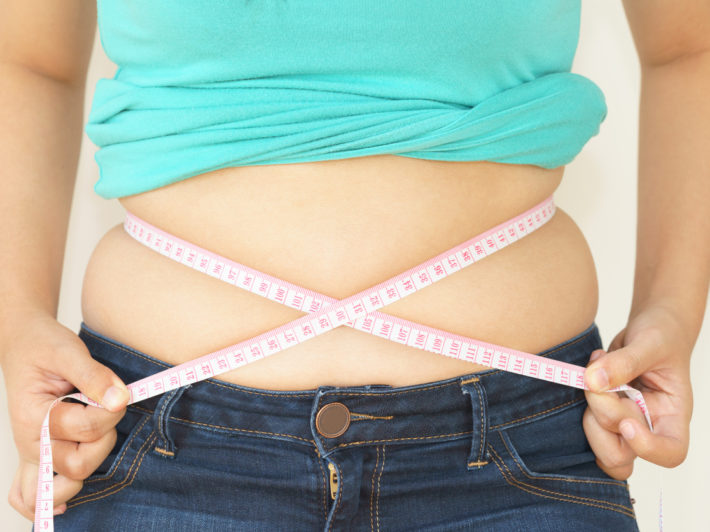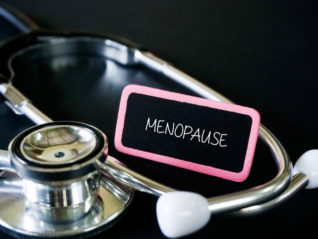
by Sara Gottfried, MD and Annalouise O’Connor, PhD, RD
Many women notice after age 45 that fat seems to accumulate readily at the waist. There are even terms for it, like menopause belly, muffin top, or “menopot.” What does the science tell us about menopausal belly fat and how to get rid of it? What are the hormonal drivers and are they amenable to change with personalized lifestyle medicine? Certainly belly fat, specifically subcutaneous and visceral abdominal fat, increases during menopause,1-3 when the changing hormonal environment can bring with it a remodeling of fat storage patterns. Abdominal fat, especially visceral fat, is biochemically different and more metabolically active than fat stored in other areas, secreting more pro-inflammatory cytokines and adipokines.4 That means preventing or reversing belly fat is not just a vanity project, it’s a meaningful step in managing a woman’s overall health, as abdominal fat has been consistently linked with insulin resistance, impaired glucose control, and overall higher cardiometabolic and breast cancer risk. Practitioners are often asked ‘How can I get rid of menopausal belly fat?’, and it is important to remember that effective management is multifaceted – encompassing an understanding how changes in sex steroids interact with other endocrine systems and also with lifestyle choices, and recognizing the best time to implement a lifestyle medicine approach is in the years before a woman’s final menstrual period.
The changing hormonal environment
A robust understanding of the hormonal changes associated with perimenopause and menopause can guide women toward effective intervention. Here are the top five hormonal changes associated with the menopausal transition.
- Changes in estrogen and estrogen dominance: Menopause is often framed simply as the loss of estrogen, but the road from pre- to post-menopausal estrogen levels is not necessarily smooth. Although loss of estrogen itself is linked with increasing abdominal fat,2,3 paradoxically the estrogen dominance that occurs in perimenopause and that may continue into menopause is seen clinically as a culprit in expanding abdominal fat mass.5 Between age 35 and 45, most women are beginning to run low on ripe eggs and experience hormonal changes linked with advancing reproductive age.6 During this time reduced progesterone coupled with high and erratic estrogen occurs.6,7 Estrogen declines but is in relative excess to progesterone. This is the definition of estrogen dominance: having a progesterone level that’s less than 100X the level of estrogen, creating an imbalance in the estrogen-progesterone partnership and essentially an inadequate level of progesterone to keep estrogen in check. Local estrogen production in adipose tissue can also contribute to estrogen dominance during this time. For example, aromatase enzymes, responsible for converting androgens to estrogens, are more active in visceral adipose tissue of post-menopausal women in response to cortisol.8
- Cortisol: Dysregulation of the HPA axis and cortisol excess can manifest as increased central and visceral fat mass and metabolic disturbances such as insulin resistance.9,10 Increased production of cortisol,11 and conversion of cortisone (inactive) to cortisol (active) has been described in post-menopausal women,12 indicating that increased cortisol synthesis and conversion could contribute to metabolic dysfunction in these women. Cortisol is regulated in part by sex steroids, and estrogen down-regulates the expression and activity 11β-HSD1, the enzyme involved in converting inactive cortisone to active cortisol13 – so higher estrogen, lower 11β-HSD1 and less active cortisol formed. Declining estrogen levels during menopause can have a knock-on effect on cortisol formation, and 11β-HSD1 has been shown to be upregulated particularly in visceral fat in post-menopausal compared with pre-menopausal women. 1,11,12 As well as contributing directly metabolic dysfunction, higher cortisol can feed back to hormonal environment and contribute to estrogen dominance occurring at this time through cortisol-induced aromatase activity.8,14
- Insulin: Fat cells accumulating in the abdomen is linked with insulin resistance. The pro-inflammatory cytokines produced by abdominal fat interferes with insulin signaling.15 This results in insulin resistance where cell response to insulin is lost, which creates a cycle where greater production of insulin is required to manage blood glucose levels. Insulin is a gatekeeper of metabolism, and rising insulin levels can set off a chain reaction that ultimately leads to a cycle of weight and abdominal fat gain. Insulin can lower production of sex hormone binding globulin (SHBG) in the liver.16,17 Lower SHBG results in greater free androgens and estrogens in circulation, and is linked with visceral fat and insulin resistance in menopausal women.18,19 In addition, insulin resistance can have a knock-on effect on leptin, insulin’s cousin.
- Leptin: Leptin is the put-down-your-fork hormone, the one that tells you when you are full.20 Elevated insulin levels eventually lead to elevated leptin, which despite what you may think, does not mean you are more likely to put down your fork and stop eating. Instead, consistently elevated leptin levels lead to a dysfunction of leptin receptors and they stop sending signals to the brain to tell you to stop eating – this is called leptin resistance.21 The mechanisms driving leptin-resistance are complex, but high intakes of refined carbohydrates have linked with its development.22
- Thyroid hormones: Thyroid hormones, which regulate how quickly we burn calories and maintains our metabolism, can becomes unbalanced with age, a trend that has been labeled ‘thyropause’. If the thyroid becomes underactive, this can lead to symptoms including weakness, fatigue, and weight gain.23
What can be done?
One of the biggest myths in women’s health is that once hormones change with menopause, abdominal adiposity is immovable – however addressing modifiable hormones such as cortisol and insulin in the following ways can have an impact.
- Make foundational changes to dietary intake. When evaluating diet, consider factors that influence insulin levels, such as high carbohydrate intakes or intake of refined carbohydrates which require greater insulin response to manage spikes in plasma glucose. Remove inflammatory or trigger foods, as inflammation can contribute to insulin resistance.31 Add in foods rich in antioxidants which promote detoxification. Eliminate alcohol which robs you of deep sleep and lowers metabolism by more than 70% for 24 hours. Choosing when to eat during the day can also make a positive impact to insulin levels and insulin sensitivity. Time-restricted feeding (TRF) protocols, a type of intermittent fasting, where food is consumed during a limited number of hours per day (often 6 or 8) has been shown to reduce body weight and abdominal fat32 and improve insulin sensitivity even without weight loss.33
- Add more movement to the day. Sitting is like the new smoking. Approximately 35 chronic diseases and conditions are associated with sedentariness, and sedentary behavior makes people more prone to gain body fat.24 High intensity interval training (HIIT) is effective at reducing abdominal and visceral adiposity, as well as improving insulin sensitivity and building muscle.25,26 Studies in post-menopausal women show that HIIT training results in greater abdominal and visceral fat mass loss compared to continuous exercise programs (where heart rate was maintained at a constant level)27,28 showing that HIIT is a time-efficient strategy for improving central obesity in this population. In addition to HIIT programs, practicing yoga can be recommended for menopausal women, showing significant reductions in menopausal symptoms.29 In broader populations, interventions that included yoga asanas were associated with reduced evening and waking cortisol levels, as well as improved metabolic symptoms.30
- Support reparative sleep. A primary step to losing belly fat is to get enough sleep and to make it quality sleep. Epidemiological studies have repeatedly shown links between sleep duration and the risk of obesity and central adiposity.34 People sleeping 7-8 hours/night night have been shown to accumulate less visceral fat mass than those sleeping for ≤6 hours/night.35 Sleep debt leads to changes in leptin and other hormones related to satiety, greater feelings of hunger, dietary indiscretion and poor food choices, as well as reduced physical activity and insulin resistance.34 In other words, getting that solid sleep needs to be a priority. As well as sleep quantity, sleep quality has to be considered, as poorer sleep quality is associated with higher visceral fat mass.36 Subjective poor sleep quality is linked with altered cortisol response37 and insulin resistance in postmenopausal women.38
Citations
- Yamatani H et al. Association of estrogen with glucocorticoid levels in visceral fat in postmenopausal women. Menopause. 2013;20(4):437-442.
- Shen W et al. Sexual dimorphism of adipose tissue distribution across the lifespan: a cross-sectional whole-body magnetic resonance imaging study. Nutr Metab (Lond). 2009;6:17.
- Lovejoy JC et al. Increased visceral fat and decreased energy expenditure during the menopausal transition. Int J Obes (Lond). 2008;32(6):949-958.
- de Heredia FP et al. Obesity, inflammation and the immune system. Proc Nutr Soc. 2012;71(2):332-338.
- Prior JC. Progesterone for symptomatic perimenopause treatment – progesterone politics, physiology and potential for perimenopause. Facts Views Vis Obgyn. 2011;3(2):109-120.
- Hale GE et al. Hormonal changes and biomarkers in late reproductive age, menopausal transition and menopause. Best Pract Res Clin Obstet Gynaecol. 2009;23(1):7-23.
- Hale GE et al. Endocrine features of menstrual cycles in middle and late reproductive age and the menopausal transition classified according to the Staging of Reproductive Aging Workshop (STRAW) staging system. J Clin Endocrinol Metab. 2007;92(8):3060-3067.
- McTernan PG et al. Glucocorticoid regulation of p450 aromatase acitivty in human adipose tissue: gender and site differences. J Clin Endocrinol Metab. 2002;87(3):1327-1336.
- Paredes S et al. Cortisol: the villain in metabolic syndrome? Rev Assoc Med Bras (1992). 2014;60(1):84-92.
- Incollingo Rodriguez AC et al. Hypothalamic-pituitary-adrenal axis dysregulation and cortisol activity in obesity: a systematic review. Psychoneuroendocrinology. 2015;62:301-318.
- Li S et al. Effects of menopause on hepatic 11β-hydroxysteroid dehydrogenase type 1 actvity and adrenal sensitivity to adrenocorticotropin in healthy non-obese women. Gynecol Endocrinol. 2011;27(10):794-799.
- Andersson T et al. Tissue-specific increases in 11β-hydroxysteroid dehydrogenase type 1 in normal weight postmenopausal women. PLoS One. 2009;4(12):e8475.
- Andersson T et al. Estrogen reduces 11β-hydroxysteroid dehydrogenase type 1 in liver and visceral, but not subcutaneous, adipose tissue in rats. Obesity (Silver Spring). 2010;18(3):470-475.
- McTernan PG et al. Gender differences in the regulation of P450 aromatase expression and activity in human adipose tissue. Int J Obes Relat Metab Disord. 2000;24(7):875-881.
- Castro AV et al. Obesity, insulin resistance and comorbidities? Mechanisms of association. Arq Bras Endocrinol Metabol. 2014;58(6):600-609.
- Plymate SR et al. Inhibition of sex hormone-binding globulin production in the human hepatoma (Hep G2) cell line by insulin and prolactin. J Clin Endocrinol Metab. 1988;67(3):460-464.
- Loukovaara M et al. Regulation of production and secretion of sex hormone-binding globulin in HepG2 cell cultures by hormones and growth factors. J Clin Endocrinol Metab. 1995;80(1):160-164.
- Davis SR et al. The contribution of SHBG to the variation in HOMA-IR is not dependent on endogenous oestrogen or androgen levels in postmenopausal women. Clin Endocrinol (Oxf). 2012;77(4):541-547.
- Janssen I et al. Testosterone and visceral fat in midlife women: the Study of Women’s Health Across the Nation (SWAN) fat patterning study. Obesity (Silver Spring). 2010;18(3):604-610.
- Klok MD et al. The role of leptin and ghrelin in the regulation of food intake and body weight in humans: a review. Obes Rev. 2007;8(1):21-34.
- Engin A. Diet-induced obesity and the mechanism of leptin resistance. Adv Exp Med Biol. 2017;960:381-397.
- Harris RBS. Development of leptin resistance in sucrose drinking rats is assocated with consuming carbohydrate-containing solutions and not calorie-free sweet solution. Appetite. 2018;132:114-121.
- Diamanti-Kandarakis E et al. Mechanisms in endocrinology: aging and anti-aging: a combo-endocrinology overview Eur J Endocrinol. 2017;176(6):R283-R308.
- Levine JA. Sick of sitting. Diabetologia. 2015;58(8):1751-1758.
- Boutcher SH. High-intensity intermittent exercise and fat loss. J Obes. 2011;2011:868305.
- Maillard F et al. Effect of high-intensity interval training on total, abdominal and visceral fat mass: a meta-analysis. Sports Med. 2018;48(2):269-288.
- Maillard F et al. High-intensity interval training reduces abdominal fat mass in postmenopausal women with type 2 diabetes. Diabetes Metab. 2016;42(6):433-441.
- Nunes PRP et al. Effect of high-intensity interval training on body composition and inflammatory markers in obese postmenopausal women: a randomized controlled trial. Menopause. 2018;Oct 1.
- Cramer H et al. Yoga for menopausal symptoms-a systematic review and meta-analysis. Maturitas. 2018;109:13-25.
- Pascoe MC et al. Yoga, mindfulness-based stress reduction and stress-related physiological measures: a meta-analysis. Psychoneuroendocrinology. 2017;86:152-168.
- Caputo T et al. From chronic overnutrition to metainflammation and insulin resistance: adipose tissue and liver contributions. FEBS Lett. 2017;591(19):3061-3088.
- Gabel K et al. Effects of 8-hour time restricted feeding on body weight and metabolic disease risk factors in obese adults: a pilot study. Nutr Healthy Aging. 2018;4(4):345-353.
- Sutton EF et al. Early time-restricted feeding improves insulin sensitivity, blood pressure, and oxidative stress even without weight loss in men with prediabetes. Cell Metab. 2018;27(6):1212-1221.e3.
- Koren D et al. Role of sleep quality in the metabolic syndrome. Diabetes Metab Syndr Obes. 2016;9:281-310.
- Chaput JP et al. Change in sleep duration and visceral fat accumulation over 6 years in adults. Obesity (Silver Spring). 2014;22(5):E9-12.
- Sweatt SK et al. Sleep quality is differentially related to adiposity in adults. Psychoneuroendocrinology. 2018;98:46-51.
- Huang T et al. Habitual sleep quality and diurnal rhythms of salivary cortisol and dehydroepiandrosterone in postmenopausal women. Psychoneuroendocrinology. 2017;84:172-180.
- Kline CE et al. Poor sleep quality is associated with insulin resistance in postmenopausal women with and without metabolic syndrome. Metab Syndr Relat Disord. 2018;16(4):183-189.
Sara Gottfried, MD is a board-certified gynecologist and physician scientist. She graduated from Harvard Medical School and the Massachusetts Institute of Technology and completed residency at the University of California at San Francisco. Over the past two decades, Dr. Gottfried has seen more than 25,000 patients and specializes in identifying the underlying cause of her patients’ conditions to achieve true and lasting health transformations, not just symptom management.
Dr. Gottfried is a global keynote speaker who practices evidence-based integrative, precision, and Functional Medicine. She recently published a new book, Brain Body Diet and has also authored three New York Times bestselling books: The Hormone Cure, The Hormone Reset Diet, and Younger.
Annalouise O’Connor, PhD, RD is the R&D Manager for Therapeutic Platforms and Lead for Cardiometabolic and Obesity platforms at Metagenics. Her role involves research coordination, as well as developing formulas for targeted nutrition solutions and programs to assist practitioners in the optimal management of their patients’ health. Annalouise trained as an RD and worked in clinical and public health settings. Dr. O’Connor completed her PhD in the Nutrigenomics Research Group at University College Dublin (Ireland) and postdoctoral work at the UNC Chapel Hill Nutrition Research Institute.





